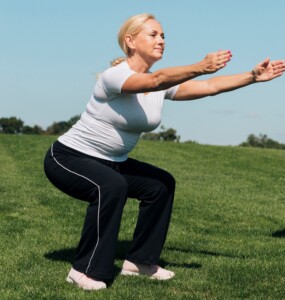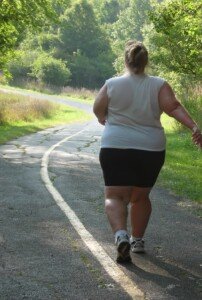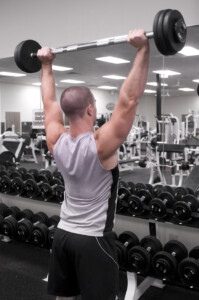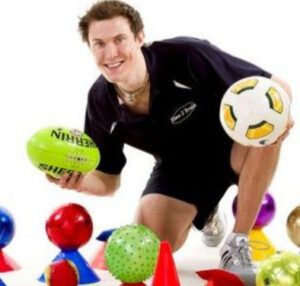Far fewer autistic people exercise when compared to neurotypicals. They’re missing out on so many benefits! Here’s your guide to getting started!
A gym membership isn’t necessary to get in great shape, though for some autistic people, a gym may be quite suitable for them due to the variety of equipment and onsite assistance (e.g., a spot on a lift or questions answered about a particular exercise).
Plus, you can still work out quite effectively by using just your body (e.g., squats, stationary lunges, broad jumping and pushups).

The bodyweight squat
“Exercise is important to everyone, but for individuals on the spectrum, I see exercise as a real opportunity to improve their overall anxiety, stress levels whilst learning more about themselves,” says Jeremy Samson, managing director and personal trainer for Time 2 Train’s Asperger’s Program in Melbourne Victoria, Australia.
Jeremy was diagnosed with Autism Spectrum Disorder at age six.
A complete workout program can be conducted in one’s home.
However, some autistic people are able to manage the sensory experiences at a gym.
Plus, a gym’s loudness can be significantly reduced with earplugs or noise cancelling headphones. And some gyms are quieter.
Nevertheless, one’s home and even the outdoors make great workout spaces.

“Unfortunately for many on the Spectrum, they are more easily attracted to sedentary lifestyle routines and may be looking for ways to ‘cut corners’ — applying minimal effort for maximum enjoyment,” says Jeremy.
“This may be recognized as a highly intelligent way of thinking, but not always necessarily healthy or ideal.
“This may be a factor to why many may be attracted to playing videogames or other similar activities.
“Another factor may simply be looking for ways to live a stress-free life.
“I have no doubt there are many who pursue a routine of both training in the gym, or privately in their own time, acknowledging that exercise training and improving physical health both supports managing stress, anxiety levels and in turn improving the capacity to ‘blend in’ society more confidently.”
I myself have an official diagnosis of Autism Spectrum Disorder. I’ve been lifting weights since 15.
At no point since age 15 have I ever been able to imagine life without pressing and pulling against heavy resistance.
Building muscle and strength empowered me in a way that nothing else could.
Maybe I was attracted to this pursuit as a way to compensate for deficits in social skills. If I couldn’t have friends, I could sure as hell have strength.
No matter what I was ever going to do in life, people were always going to think I was weird – whether I was physically weak or physically strong.
So, if people were going to think I was weird, I might as well be strong!
Being unable to fit in with any group is a lot easier to handle when you know you’re significantly stronger than anyone in that group!

Shutterstock/Lyashenko Egor
My advice to autistic people who are struggling with their neurodiversity is to head straight to the gym after work instead of masking around neurotypicals at some bar’s happy hour.
The bar you want to go to after a stressful day on the job is the one that’s made of metal that can be lifted above your head or picked up from the floor.

While you’re sculpting and strengthening your one-and-only body and making it less likely to develop disease, your NT coworkers are at the bar guzzling alcohol and potentially harming their liver and impairing their judgment.
Even if you don’t have money for a gym membership, you can do many exercises at home – and cheaply.
Often, though, the money is there — but being spent too much on videogames and junk food.
Autism Is All the More Reason to Work Out
After Jeremy was diagnosed, he was placed on an exercise program.
“I became further involved in health and fitness in my teen years to find a way to help boost my self-confidence as well as support others in their journey towards improving their health.
“After losing my father to a sudden heart attack at age 10 and the years of grief I unfortunately suffered, I used my father’s death to inspire a journey to support and prevent others from losing their health.
“Having grown up being a part of an exercise routine, the benefits shaped and changed the way I functioned and behaved, especially in public and in school.
“I was able to manage and cope better, my ability to learn and process became easier as well as feeling more confident in myself overtime.
“Having grown up participating in a daily exercise, movement routine from a very young age as part of my early intervention, I discovered the benefits along with change in my diet, nutrition early on lead to greater improvements to my overall health.”
• Treadmill Basics
• Walking Workouts
• Resistance Band Exercises
• Strength Training for Beginners
• Stationary Bike Guidelines
• Dumbbell Routines for Women
• Tone the Entire Body with the Deadlift
Time 2 Train strives through exercise and sports combined with games to assist youth and adults with ASD and learning challenges to build confidence, improve coordination, and develop social and coping skills to enable them to become valued members of our society.
 Lorra Garrick has been covering medical and fitness topics for many years, having written thousands of articles for print magazines and websites, including as a ghostwriter. She’s also a former ACE-certified personal trainer. In 2022 she received a diagnosis of Level 1 Autism Spectrum Disorder.
Lorra Garrick has been covering medical and fitness topics for many years, having written thousands of articles for print magazines and websites, including as a ghostwriter. She’s also a former ACE-certified personal trainer. In 2022 she received a diagnosis of Level 1 Autism Spectrum Disorder.
.




























